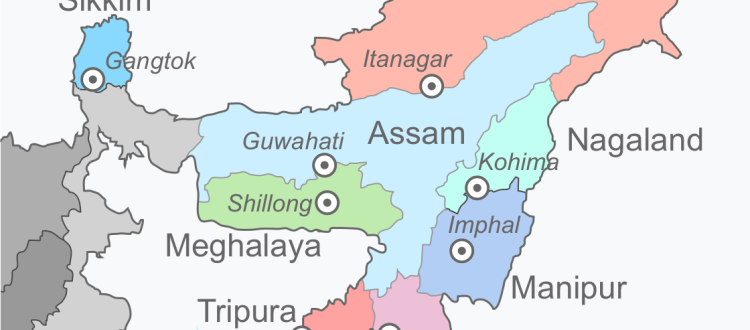The Symmetrical Turn in India’s Asymmetric Federalism
I use actor-centered historical institutionalism (Broschek 2012, Scharpf 1997, Tillin 2013, 2015) as an analytical framework to understand the symmetrical turn in India’s asymmetric federalism by examining three recent developments: firstly, the revocation of Jammu and Kashmir’s constitutional asymmetry under Article 370 in August 2019, secondly, attempts by the federal government during 2012-13 to neutralise the special constituent power of Nagaland Legislative Assembly under Article 371A to make inapplicable any law made by the parliament over ‘land and resources’, and thirdly, the attempt by the State of Manipur in early September 2021 to dilute sub-State asymmetry that its hill areas enjoy under Article 371C. While the first and the third developments were enacted by congruent political actors (here BJP-led government) respectively at the federal and subnational level, the second marks the indelible imprint of a national actor (Congress-led UPA government) at a time an incongruent regionalist party called the Naga People’s Front (NPF) was in power at the subnational level.

Kham Khan Suan Hausing
University of Hyderabad
These developments underscore that far from being unilinear and simple, the path-dependent nature of institutional change is complex. While the case of Jammu and Kashmir presents a successful yet problematic path-dependent recourse by the BJP to use a pliant governor as a proxy to the State Assembly (F.N.1) whose concurrence to effect change in Article 370 is constitutionally mandated, the case of Nagaland offers an interesting puzzle where despite persistent meta-narrative dissensus among the ranks of Naga nationalists the ability of various political actors to forge overarching consensus over, and united stand, to defend Nagaland’s special powers over ‘land and resources’ ensure that an integrationist project from the top is forestalled for now. Similar integrationist push in Manipur remains temporally forestalled. Yet, given the propensity of various actors to leverage partisan or segmental tribe interest over overarching interest of the tribal hill areas, sub-State constitutional asymmetry that Manipur’s hill areas enjoy under Article 371C continues to remain precarious.
Arguments
I argue that the symmetrical turn in India’s asymmetric federalism represents a tangible yet unsettled culmination of a long-drawn integrationist project of political actors at a time marked by complex alignment of the ideas, interests and agenda of both national and subnational level actors on the one hand, and the favourable political opportunity structure opened up by the electoral consolidation of the BJP at the national level and in several States since 2014 on the other hand. Mindful that asymmetrical federal institutions like asymmetric federalism under Article 370 in Jammu and Kashmir, the omnibus Article 370 and the Sixth Schedule in Northeast India are embedded in complex power relations which are ‘sticky’ to change, this paper seeks to nuance how the complex interplay of actors with their variegated agenda, ideas and interest interact with contexts and structures of institutions in accounting for institutional change.
I argue that the three developments outlined above also underscore how and why accounts on asymmetric federalism as a normative idea and an institutional arrangement to manage conflicts by recognizing and territorially accommodating ‘deep diversity’ in India are likely to be incomplete by a singular focus on the role of the BJP. While mindful of the aggressive and defining role of the BJP in facilitating this symmetrical turn, especially given that it is known to be particularly hostile to the idea of asymmetric federalism, in this paper I examine the genealogy and nature of asymmetric federalism in India to historically locate the equally important yet incremental role of actors within the Congress party in leveraging this integrationist project. Going against a grain of literature which suggests that asymmetric federalism is not central to India’s institutional imaginary and conflict management (Tillin 2007), this paper suggests that asymmetric federalism lies at the heart of India’s ability to manage conflicts by transforming former separatists like Kashmiris in Jammu and Kashmir on the one hand, and Naga, Mizo and Bodo in Northeast India on the other hand into important stakeholders of its federal polity (Bose 2005, Ganguly 1997, Hausing 2014, 2022, Stepan et al 2011). The BJP’s stated position on asymmetric federalism as ‘secession- inducing’ — to wit Erk and Anderson (2009) — and its recent move to revoke Article 370 in Kashmir and dilute Article 371C in Manipur and its aggressive integrationist push to establish a homogenous nation-state is likely to constrain the ability of India’s federal polity to territorially manage conflicts and ‘hold together’ deeply diverse societies (Hausing 2021, Nair 2019).
Kham Khan Suan Hausing is Professor and Head of the Department of Political Science, University of Hyderabad, Hyderabad, India. He is also a Senior Honorary Fellow at the Centre for Multilevel Federalism, Institute of Social Sciences, New Delhi Email: kksuanh@uohyd.ac.in. This is a preliminary draft paper to be presented during the international conference on ‘Federalism in times of crisis’ being organized the Central University of Haryana in collaboration with Hanns Seidel Foundation, India at the India International Centre, New Delhi, 6-9 December 2022.
NOTES
- In doing so, the BJP draws from a path-dependent trajectory laid overtime by the Congress by intermittently extending the provisions of the Indian constitution since the 1950s and 1960s through pliant State governments. The State Autonomy Committee constituted by the National Conference reported in 2000 the persistent erosion of autonomy of the State, which as a result ‘has lost all resemblance to autonomy’ (Government of Jammu and Kashmir 2000: 5).
REFERENCES
Aiyer, Yamini and Louise Tillin (2020), “One nation’, BJP and the future of Indian federalism,” India Review 19(2): 117-35.
Bose, Sumantra (2005), Kashmir: Roots of conflict, paths to peace. Harvard, Mass: Harvard University Press.
Broschek, Jorg (2012), “Historical institutionalism and the varieties of federalism in Germany and Canada,” Publius: The Journal of Federalism, 42(4): 662-87.
Erk, Jan and Lawrence Anderson (2009), “The paradox of federalism: Does self-rule accommodate or exacerbate ethnic divisions?’ Regional and Federal Studies 19(2): 191-202.
Ganguly, Sumit (1997), The crisis in Kashmir: Portents of war, hopes of peace. New York: Cambridge University Press.
Government of Jammu and Kashmir (2000), Report of the State Autonomy Committee. Srinagar: General Administration Department.
Government of India (2019), Lok Sabha Debates on Jammu and Kashmir Reorganisation Bill, 2019, 6 August.
Hausing, Kham Khan Suan (2014), “Asymmetric federalism and the question of democratic justice in Northeast India,” India Review 13(2): 87-111.
Hausing, Kham Khan Suan (2021), “In Manipur, a case for asymmetric federalism,” The Hindu, Delhi,14 September, op-ed.
Hausing, Kham Khan Suan (2022), “Autonomy and the territorial management of ethnic conflicts in Northeast India,” Territory, Politics, Governance 10(1): 120-43.
Nair, Balu G. (2019), “Abrogation of Article 370: Can the President act without the recommendation of the constituent assembly?” India Law Review 3(3): 254-279.
Scharpf, Fritz W (1997), Games real actors play: Actor-centered institutionalism in policy research (Theoretical lenses on public policy). Westview Press.
Sharma, Chanchal Kumar and Wilfried Swenden (2022), “The dynamics of federal (in)stability and negotiated cooperation under single-party dominance: Insights from Modi’s India,” Contemporary South Asia, Doi: https://doi.org/10.1080/09584935.2022.2132218
Stepan, Alfred, Juan J. Linz, and Yogendra Yadav (eds) (2011), Crafting state-nations: India and other multinational democracies. Baltimore: The John Hopkins University Press.
Tillin, Louise (2007), “United in diversity? Asymmetry in Indian federalism,” Publius: The Journal of Federalism 37(1): 45-67.
Tillin, Louise (2013), Remapping India: New states and their political origins. London: Hurst & Co.
Tillin, Louise (2015), ‘Explaining territorial change in federal Democracies: A comparative historical institutionalist approach’, Political Studies 63(3): 626-41.
Copyright: © (2022) The Author


Everything is very open with a very clear clarification of the challenges. It was definitely informative. Your website is useful. Thank you for sharing!
I really like your writing style..Its so easily understandable